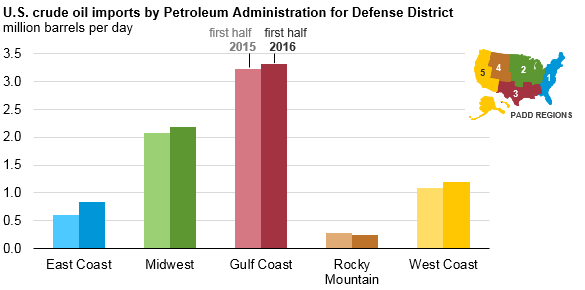U.S. Crude Imports Increase

U.S. gross crude oil imports increased by 528,000 barrels per day (b/d), or seven percent, during the first half of 2016 compared to the first half of 2015. This increase reverses a multiyear trend of decreasing U.S. crude oil imports as a result of increasing U.S. production.

Imports from Nigeria, Iraq, and other members of OPEC rose by 504,000 b/d. Declining imports from Mexico, which fell 118,000 b/d, more than offset the increase in imports from Canada, limiting the net change in imports from non-OPEC countries to an increase of less than 24,000 b/d.

Changes in crude oil price spreads were a significant factor in the rise of U.S. oil imports during the first half of 2016. The narrowing price differences between U.S. crudes and international benchmarks provided an incentive for increased imports by refiners in areas where imported crudes now had a delivered cost advantage relative to similar domestic crudes.
Additionally, lower overall crude prices contributed to a decline in U.S. crude production from an average of 9.5 million b/d in the first half of 2015 to 9.0 million b/d in the first half of 2016, resulting in higher net crude oil imports.

As a result of shifting price, supply, and logistical dynamics, East Coast crude imports rose by 244,000 b/d (41 percent) in the first half of 2016 compared to the same period in 2015, nearly three-quarters of which were supplied by Nigeria. Nigerian production actually declined during the first half of 2016 as a result of elevated supply disruptions.
However, falling U.S. production and increasing competitiveness for seaborne light sweet crudes into the East Coast more than offset lower production levels, enabling imports from Nigeria to displace crude oil received from the Midwest.
In the Midwest, crude imports rose by 104,000 b/d (five percent) during the first half of 2016 compared with the same time last year. Canada accounted for almost all of the increase despite wildfires in Alberta that disrupted production later in the second quarter. Canada is the largest source of crude oil imported into the United States, and its heavy crude is particularly well suited for U.S. refiners in the Midwest and Gulf Coast.
Gulf Coast imports increased 88,000 b/d (three percent), with rising imports from Middle East and African countries offsetting declines from Latin America. Imports from Iraq increased by 142,000 b/d, more than the next four countries combined. Iraq’s production in 2015 rose by 700,000 b/d, enabling more of their production to be exported to the United States.
The Rocky Mountain region is the only region with declining imports during the first half of 2016, with volumes down by 24,000 b/d (nine percent). This region is relatively isolated from import infrastructure compared with other regions, and imports have been entirely sourced from Canada for more than a decade, a trend that continued during the first half of 2016.
